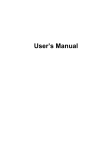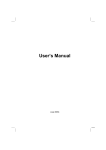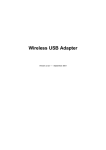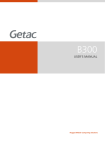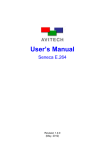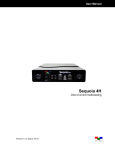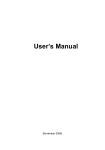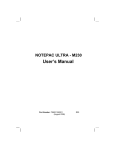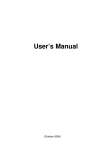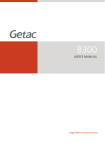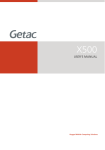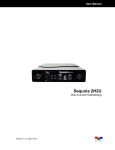Download Trimble Rugged Tablet Computer User`s Manual
Transcript
Trimble Rugged Tablet Computer User’s Manual R01 April 2009 © 2009 Trimble Navigation Limited. All rights reserved. TRADEMARKS Trimble and the Globe & Triangle logo are trademarks of Trimble Navigation Limited, registered in the United States Patent and Trademark Office and in other countries. Yuma is a trademark of Trimble Navigation Microsoft, Vista, and the Windows logo are either registered trademarks or trademarks of Microsoft Corporation in the United States and/or other countries. Microsoft products are licensed to OEMs by Microsoft Licensing, Inc., a wholly owned subsidiary of Microsoft Corporation. ® The Bluetooth word mark and logos are registered trademarks owned by Bluetooth SIG, Inc. All other brand and product names are trademarks or registered trademarks of their respective owners. NOTE Display images shown may vary slightly from actual display. Information in this manual is subject to change without notice. Table of Contents Preface…….. .............................................................................. iv Chapter 1 Getting Started ................................................... 1-1 Getting the Tablet Computer Running ................................. 1-2 Unpacking ........................................................................ 1-2 Installing Battery Packs and Connecting to AC Power .... 1-3 Turning the Tablet Computer On and Off ........................ 1-6 Taking a Look at the Tablet Computer ................................ 1-8 Front Side ......................................................................... 1-8 Rear Side ........................................................................ 1-10 Bottom Side .................................................................... 1-11 Expansion Slot Side ....................................................... 1-12 Chapter 2 Operating Your Tablet Computer ..................... 2-1 Using the Touchscreen ......................................................... 2-2 Touchscreen Kit ............................................................... 2-3 Using the Input Panel ........................................................... 2-5 Using the Audio Features ..................................................... 2-6 Connecting Audio Devices............................................... 2-7 Using the Communication Features ..................................... 2-8 Using the Wireless LAN (WiFi) ...................................... 2-8 Using the Bluetooth Wireless Feature ............................ 2-12 Using the GPS ................................................................ 2-14 Using the Camera ............................................................... 2-22 Using the G-Camera Application ................................... 2-22 Chapter 3 Managing Power ................................................ 3-1 Battery Pack ......................................................................... 3-2 Charging the Battery Pack ............................................... 3-2 Initializing the Battery Pack ............................................. 3-3 i Checking the Battery Level .............................................. 3-3 Replacing the Battery Pack .............................................. 3-3 Battery Low Signals and Actions ..................................... 3-4 Power Management .............................................................. 3-6 Sleep Mode....................................................................... 3-6 Hibernation Mode ............................................................ 3-7 Power-Saving Tips ............................................................... 3-8 Chaptedr 4 Expanding Your Tablet Computer .................... 4-1 Connecting a Serial Device .................................................. 4-2 Connecting a USB Device .................................................... 4-3 Using ExpressCards ............................................................. 4-4 ExpressCard Type ............................................................ 4-4 Inserting and Removing an ExpressCard ......................... 4-4 Using the SD Card Reader ................................................... 4-6 Chapter 5 Using BIOS Setup and System Utility .............. 5-1 When to Use BIOS Setup Utility ..................................... 5-2 Starting BIOS Setup Utility ............................................. 5-2 Moving Around and Making Selections .......................... 5-4 Information Menu ................................................................ 5-5 Main Menu ........................................................................... 5-6 Advanced Menu ................................................................... 5-7 Boot Menu ............................................................................ 5-8 Exit Menu ............................................................................. 5-9 Using the System Utility .................................................... 5-10 Wireless Switch .............................................................. 5-10 Quick Button Define ...................................................... 5-10 Help ................................................................................ 5-12 Chatper 6 Caring for the Tablet Computer ........................ 6-1 Taking Care of the Tablet Computer .................................... 6-2 Location Guidelines ......................................................... 6-2 General Guidelines ........................................................... 6-2 Cleaning Guidelines ......................................................... 6-2 Battery Pack Guidelines ................................................... 6-2 ii Touchscreen Guidelines ................................................... 6-3 Chatper 7 Troubleshooting ................................................ 7-1 Preliminary Checklist ........................................................... 7-2 Solving Common Issues ....................................................... 7-3 Battery Problems .............................................................. 7-4 Bluetooth Wireless Transmission Problems .................... 7-4 Display Problems ............................................................. 7-5 Hardware Device Problems .............................................. 7-5 Hard Disk Drive Problems ............................................... 7-5 Wireless LAN Problems .................................................. 7-6 Power Management Problems .......................................... 7-7 Software Problems ........................................................... 7-8 Sound Problems ............................................................... 7-8 Startup Problems .............................................................. 7-9 Other Problems................................................................. 7-9 Resetting the Tablet Computer ........................................... 7-10 Warning Messages ............................................................. 7-11 G-Camera Application ................................................... 7-11 Virtual-GPS Application ................................................ 7-12 System Utility................................................................. 7-13 Appendix A Regulatory Information .................................... A-1 On the Use of the System .....................................................A-2 Class B Regulations .........................................................A-2 Safety Notices ..................................................................A-3 On the Use of the RF Device................................................A-5 USA and Canada Safety Requirements and Notices ........A-5 European Union CE Marking and Compliance Notices ..A-7 ENERGY STAR ................................................................A-11 Earning the ENERGY STAR® .......................................A-11 Remember, saving energy prevents pollution ................A-12 iii Preface This manual contains information that will help you operate this rugged tablet computer. It is divided into 7 chapters and 1 appendix. iv Chapter 1, Getting Started, takes you through the process of setting up the tablet computer and identifying its external components. Chapter 2, Operating Your Tablet Computer, tells you how to use the tablet computer’s components and features. Chapter 3, Managing Power, provides information on power management. Chapter 4, Expanding Your Tablet Computer, provides information on installing and using peripheral devices. Chapter 5, Using BIOS Setup, describes the BIOS Setup program that configures the tablet computer’s BIOS settings. Chapter 6, Caring for the Tablet Computer, gives you tips on care and maintenance. Chapter 7, Troubleshooting, gives solutions to common problems you may encounter when using the tablet computer. Appendix, Regulatory Information, provides regulatory statements and safety notices on your tablet computer. Notational Conventions Throughout this manual, the following conventions are used to distinguish elements of text. NOTE: identifies additional information that requires special attention. CAUTION: identifies important information that, if not followed, may result in loss of data or damage to the tablet computer. Keypad keys are shown in a bold typeset. For example: Press the F1 key to complete. A title, command, setup item, or button that you can see on the screen is shown in boldface. A value or an option that you can select for a setup item is shown in italic. For example: Select When I press the power button, set it to Shut down, and then tap the Save changes button. v Chapter 1 CHAPTER Getting Started Congratulations on purchasing this rugged tablet computer. The rugged design allows you to use it in harsh outdoor environments. You can use it under blazing heat, subzero cold, driving rain or dusty surroundings – places you could not take a consumer-grade tablet computer. This chapter tells you step by step how to get the tablet computer up and running. You will find instructions for the following procedures: Unpacking Installing Battery Packs and Connecting to AC Power Turning the Tablet Computer On and Off Taking a Look at the Tablet Computer (An Explanation of External Components and their Functions) Getting Started 1-1 Getting the Tablet Computer Running This section guides you through the procedures for getting the tablet computer ready for operation. Unpacking After unpacking the shipping carton, you should find these standard items: Tablet Computer Accessories: AC adapter and power cord Battery pack (2) Extended cap Stylus Hand strap Tether and snap Cleaning cloth Screen protector film (2) Windows Vista Certificate of Authenticity Label (COA) Quick Start Guide Inspect all the items. If any item is damaged or missing, notify your dealer immediately. Keep the shipping carton and packing materials in case you need to ship or store the tablet computer in the future. 1-2 Getting Started Installing Battery Packs and Connecting to AC Power The tablet computer operates either on the external AC power or internal battery power. It is suggested that you use AC power when you start up the tablet computer for the first time. CAUTION: Use only the AC adapter included with your tablet computer. Using other AC adapters may damage the tablet computer. 1. Fit the two battery packs into place on both sides. Getting Started 1-3 2. Remove the rubber cap from the included stylus to expose a Phillips screwdriver, or use a small #1 Phillips head screwdriver to secure the two screws on each battery taking care not to over tighten. 1-4 Getting Started 3. Plug the DC cord of the AC adapter into the power connector ( of the tablet computer (). ) 4. Plug the female end of the AC power cord into the AC adapter and the male end into an electrical outlet (). 5. When the AC adapter is connected, the battery pack is charging. The battery status indicator ( ) shows three different states: Solid green: battery is fully charged. Solid amber: battery is charging. Blinking red: battery capacity is below 10%. CAUTION: When you disconnect the AC adapter, disconnect from the electrical outlet first and then from the tablet computer. A reverse procedure may damage the AC adapter or the tablet computer. When unplugging the connector, always hold the plug head. Never pull on the cord. Getting Started 1-5 Turning the Tablet Computer On and Off Turning On 1. Make sure that the tablet computer is either connected to AC power or the battery is charged. 2. Press the power button ( ). Notice the screen appears blank for 8-10 seconds but the power LED lights up. The power indicator ( ) shows 2 different states: Solid green: tablet computer is turned on. Blinking green: tablet computer is in sleep mode. 1-6 Getting Started Turning Off To turn off the tablet computer, use the ―Shut Down‖ command of your operating system. CAUTION: Wait for at least five seconds after turning off the tablet computer before turning it back on. When you finish a working session, you can stop the tablet computer by using the Vista Shut Down command, or leaving the tablet computer in Sleep or Hibernation mode: To stop in this mode... Off Hybrid Sleep Hibernation Do this... Shutdown the tablet computer as you would a regular PC running Vista. (Use the Windows Start Menu in the lower left and follow the shutdown procedure.) You can force the tablet computer to turn off by pressing and holding the power button for more than 6 seconds. (This is not the recommended method for turning off your tablet computer, but may be necessary if the system is locked up.) Press the power button for less than 4 seconds or use the Windows Start Menu to put the unit in Hybrid Sleep mode. Use the Windows Start Menu to put the tablet computer in hibernation mode. Press the power button to resume or turn on the tablet computer from any of these modes. (See ―Power Management‖ in Chapter 3 for more information.) Getting Started 1-7 Taking a Look at the Tablet Computer This section identifies the external components of the tablet computer and briefly describes the function of each component. NOTE: Depending on the model you purchased, the appearance of your tablet computer may not be exactly the same as those shown in this manual. Front Side Ref 1-8 Component Description Webcam Lens Allows you to use your tablet computer’s camera function. Indicators Shows the current status of the tablet computer’s devices. Power Solid green: tablet computer is turned on. Blinking green: tablet computer is in Sleep mode. Battery Charge Solid green: battery is fully charged. Solid amber: battery is charging. Blinking red: battery’s capacity is below 10 %. Hard Disk Drive Blinking green: hard disk drive is in use. WiFi and Bluetooth Solid green: wireless antenna is on. NOTE: WiFi/Bluetooth on/off state is set via the OSD utility. Getting Started Ref Component Description F1 Button Short press: launches Microsoft® Internet Explorer. Long press: (>2 seconds) rotates the display orientation from landscape (default) to portrait. F2 Button Short press: launches the G-Camera application. F3 Button Short press: launches the input panel. Long press: (>2 seconds) first long press locks the keypad and disables the touchscreen. The second long press unlocks the keypad and enables the touchscreen. Power Button Turns the tablet computer power ON and OFF (Hybrid Sleep mode by default). NOTE: Depending on your settings in Windows, you can place the tablet computer in Sleep/Hibernation/Shutdown mode with the power button. See “Power Management” in Chapter 3 for more information. Directional Button Serves as the UP / DOWN / LEFT / RIGHT arrow keys (except pointer on screen). F2 + UP arrow key increases the sound volume. F2 + DOWN arrow key decreases the sound volume. F2 + LEFT arrow key decreases the LCD brightness. F2 + RIGHT arrow key increases the LCD brightness. Enter Button LCD Touchscreen Displays and receives information for the tablet computer. Microphone Getting Started Serves as the Enter key. F1 + Enter key resets the computer (same as Alt+Ctrl+Del on a keyboard). F2 + Enter key places the tablet computer in power saving mode, which changes the Windows Vista Power Plan to ―Power Saver‖ mode and changes the brightness about 45 nits. Pressing F2 + Enter again turns the power saving mode OFF. Turning OFF returns the Windows Vista Power Plan to the setting before power saving mode. NOTE: The power saving mode works only when using battery power. Upon connecting AC power, your tablet computer returns to the previous state before power saving mode. Receives sound and voice for the tablet computer. 1-9 Rear Side Ref Component Description Stylus Holder Provides a convenient place to store the stylus. Use the stylus on the touchscreen and to loosen screws on the battery pack and expansion slots. NOTE: Upon unpacking your tablet computer for the first time the stylus is packaged separately. CMOS Camera Lens Allows you to use the camera function. Speaker Sends out sound and voice from your tablet computer. Battery Packs Supplies power to your tablet computer when external power is not connected. 1-10 Getting Started Bottom Side Ref Component Description Docking Connector Connects to a docking station. GPS Antenna pass-through Connector Connects to the optional antenna for GPS receiver. NOTE: Must be connected via a vehicle docking station. External GPS Antenna must be enabled in the BIOS Setup for this feature to work. USB Ports Each of the two ports connects a USB device, such as a USB flash disk, printer, digital camera, joystick, and more. Audio Output Connector Connects a set of headphones, external speakers with amplifier, or an audio recording device. Serial Connector Connects a serial communication device. Microphone Connector Power Connector Connects the AC adapter. RS232 Getting Started Connects an external microphone. 1-11 Expansion Slot Side NOTE: To access the SDIO and ExpressCard slots, use the Phillips screwdriver end of the stylus or a small #1 Phillips head screwdriver to release the four screws as shown securing the compartment cover. Ref Component Description WiFi, GPS, and Bluetooth Wireless Antenna Inside is the antenna for WiFi, GPS, and Bluetooth wireless transmission. SDIO Slot Accepts a Secure Digital (SD) card for removable storage media and I/O (input/output) function. ExpressCard Slot Accepts an ExpressCard for additional functions. 1-12 Getting Started CAUTION: There are no user-serviceable parts in the antenna compartment. Disassembly of this area will void your warranty. Do not remove Allen screws securing the antenna compartment cover. Extended Cap The extended cap allows you to protect the tablet’s seal against dust and water while using SDIO or ExpressCard’s. After removing the expansion slot cover, use the Phillips screwdriver end of the stylus or a small #1 Phillips head screwdriver to screw in the four screws on the extended cap. Getting Started 1-13 Chapter 2 CHAPTER Operating Your Tablet Computer This chapter provides information about the use of the tablet computer. Described in this chapter are the operating basics of these components/ features: Touchscreen Input Panel Audio Features Communication Features (WiFi, Bluetooth and GPS) Camera Operating Your Tablet Computer 2-1 Using the Touchscreen The touchscreen is a touch-sensitive device that allows you to easily communicate with the tablet computer by controlling the location of the pointer on the screen. NOTE: The touchscreen function is not available when running the BIOS Setup program but you can use the buttons to move around and make selections in the BIOS Setup utility screen. CAUTION: Do not use the screwdriver part of the stylus on the touchscreen or it will scratch your screen. Use only the spring-tip end of the stylus. Install the screen protector film to keep the touchscreen clean and protected. Screen protectors extend the life of the display by providing a protective and replaceable barrier between abrasive grit and the surface of the display. 2-2 Operating Your Tablet Computer Here are some common terms that you should know when using the touchscreen: Term Action Tap Tap gently on the touchscreen to select or open an item. Tapping is the same as clicking the left button on a PC mouse. Tap and hold Touch and hold the stylus lightly on the display. A circle of dots will appear to indicate that a pop-up menu will soon appear. Lift up the stylus and a pop-up menu appears. Select the desired function. This action is similar to a right mouse click on a PC. Drag Hold the stylus on the screen and drag across the screen to select text and images. Touchscreen Kit Calibration Touch Utility When there is a noticeable discrepancy in the placement of the stylus on the screen and the indicated position of the onscreen pointer, use the calibration utility under Start All Programs Touchkit CalTouch to correct the error. Operating Your Tablet Computer 2-3 Tap the RS-232 Touchscreen icon and then tap 25 Points Linearization. Tap and hold each of the 25 targets to calibrate the touchsreen. 2-4 Operating Your Tablet Computer Using the Input Panel Use the input panel to enter text and perform various keyboard functions. 1. Press F3 or tap the input panel icon located in the Windows system tray and the input panel will appear onscreen. 2. Tap the characters on the input panel with the stylus. NOTE: To protect the LCD display, use the stylus on your touchscreen. Operating Your Tablet Computer 2-5 Using the Audio Features The audio subsystem of your tablet computer features: Manual adjustment of the sound volume using the cursor-control UP arrow (sound volume up) and DOWN arrow (sound volume down) buttons 2-6 Press the F2 + UP arrow key to increase the sound volume Press the F2 + DOWN arrow key to decrease the sound volume Integrated speaker () Microphone ( ) () and audio-out ( ) () connectors Operating Your Tablet Computer Connecting Audio Devices For higher audio quality, you can send sound through external audio devices such as speakers, headphones, or earphone set using the audio-out connector. NOTE: After connecting an external audio device, make sure that you specify the use of the correct audio device in Windows. When using the external speakers/headphones, you cannot use the internal one. Operating Your Tablet Computer 2-7 Using the Communication Features Using the Wireless LAN (WiFi) A few of the WiFi features include: Peer-to-Peer (Ad-Hoc) and Access Point (Infrastructure) modes supported WEP (Wired Equivalent Privacy) 64/128-bit data encryption IEEE 802.11b/g standard compliance Technology 802.11b 802.11g Stated Maximum Throughput (Mbps) 11 54 Band (GHz) 2.412 ~ 2.462 2.4 Modulation Technology DSSS (Direct Sequence Spread Spectrum) OFDM (Orthogonal Frequency Division Multiplexing) NOTE: 802.11g mode is backward compatible with 802.11b mode. It takes approximately 30 seconds for your tablet computer to make a successful WiFi connection and approximately 10 seconds to disconnect. Turning the WiFi Radio On and Off 1. Tap and hold the stylus on the icon located in the Windows system tray until the ring appears then lift up and the menu appears. When no wireless device(s) is currently detected, it is indicated by the button highlighted as gray. The Wireless Switch is enabled (On) by default. 2-8 Operating Your Tablet Computer NOTE: If there is no icon located in the Windows system tray, tap Start All Programs System utility OSD. 2. Tap Wireless Switch, then the button will be highlighted as green. NOTE: The status of wireless devices will be the same as its status before entering Sleep mode or turning off the tablet computer. 3. Ensure that the Windows Mobility Center has Wireless turned on. Tap Start Control Panel Mobile PC Windows Mobility Center to turn on the WiFi radio by tapping Turn wireless on. Operating Your Tablet Computer 2-9 4. To turn off the WiFi radio after turning it on, tap Turn wireless off. Connecting to a Wireless Network To connect to a wireless network: 1. Make sure that the wireless LAN radio is ―on‖ indicated by the WiFi LED indicator ( ) glowing in green. 2. Tap and hold the stylus on the Wireless Network Connection icon located in the Windows system tray until the ring appears, then lift up and select Connect to a network. 2-10 Operating Your Tablet Computer 3. If any wireless network is detected, the following window appears on screen. Tap the Show drop-down menu and select Wireless. 4. Tap to select a wireless network to connect to, and then tap Connect. 5. Depending on the settings, you may be asked to enter a WEP key (refer to your Windows online help for more information on setting a wireless network connection). Operating Your Tablet Computer 2-11 Using the Bluetooth Wireless Feature Depending on your model, your tablet computer may incorporate the Bluetooth capability for short-range (about 10 meters) wireless communications between devices without requiring a cable connection. With Bluetooth, data can be transmitted through walls, pockets and briefcases as long as two devices are within range. By default, your tablet computer’s Bluetooth feature is in the discoverable and pairable mode. The status of the Bluetooth connection is indicated by the Bluetooth icon located in the Windows system tray in the lower-right part of the screen. Status Icon Off ® On ® Connected ® (blue with red logo) (blue with white logo) (blue with green logo) You can use the Bluetooth Utility to configure Bluetooth connection settings and transfer files. Turning the Bluetooth Wireless Feature On and Off 1. Tap and hold the stylus on the icon located in the Windows system tray until the ring appears, then lift up and the menu appears. When no wireless device(s) is currently detected, it is indicated by the button highlighted as gray. The Wireless Switch is enabled (On) by default NOTE: If there is no icon located in the Windows system tray, tap Start All Programs System utility OSD. 2-12 Operating Your Tablet Computer 2. Tap Wireless Switch, then the button will be highlighted as green. NOTE: The status of wireless devices will be the same as its status before entering Sleep mode or turning off the tablet computer. 3. Tap and hold the stylus on the icon located in the Windows system tray until the ring appears, then lift up and the menu appears. Tap Enable Bluetooth Radio to turn on the Bluetooth wireless feature. Note that the Bluetooth Radio is ―Enabled‖ by default Operating Your Tablet Computer 2-13 4. To turn off the Bluetooth wireless feature after turning it on, tap and hold the stylus on the icon located in the Windows system tray until the ring appears, then lift up and the menu appears. Tap Disable Bluetooth Radio to turn off Bluetooth wireless feature. NOTE: The status of wireless devices will be the same as its status before entering Sleep mode or turning off the tablet computer. For detailed information on using the Bluetooth Utility, open the Bluetooth Utility User Guide on your tablet computer by tapping Help. Tap on the Contents, Index, or Search tab to browse the contents of the User Guide. Using the GPS Your tablet computer has a GPS (Global Positioning System) receiver module built in and includes the Virtual-GPS software (Start All Programs Virtual-GPS Launch Virtual-GPS). Using the Virtual-GPS Application Virtual-GPS shows the GPS signal availability status of the system’s GPS module, allowing you to check if the GPS feature is working properly. Virtual-GPS also allows you to create virtual COM ports which can connect to two or more GPS applications at the same time. 2-14 Operating Your Tablet Computer Virtual-GPS is a unified user interface utility that allows you to manage and configure the following: GPS information Settings Data view The first time Virtual-GPS is launched it automatically scans all COM ports. If a COM port is found, the system will open the port and GPS data will be entered, all information will appear on the ―GPS Info.‖ tab and will be continuously updated. The default GPS COM port is COM2 (at 9600 baud) The GPS Info. tab provides an overview of the system status. Upon tapping Stop V-GPS, the data feed will stop (the COM port will be closed) and all the related information will be frozen on the screen until you tap the Start V-GPS button to start it up again. The next time Virtual-GPS is launched, it will remember the last state (whether the port was open and acquiring data, or closed). Operating Your Tablet Computer 2-15 A summary of the values can be viewed on the upper left side of the screen. It contains nine major values, namely: Fix Mode (2D/3D) Date Stamp Time Stamp Current Latitude Current Longitude Current Altitude Current Speed Current Course Satellites The signal indicator ( ) is displayed on the lower left side of the screen that shows the 13 satellites’ signal indicator. The length of the green bar of each satellite changes dynamically; the stronger the signal the longer the bar shown. Below each bar is the PRN (Pseudo Random Number) of each discovered satellite and the signal strength data is shown on the bottom of the bar. No PRN is shown when GPS is not functioning or no satellites are discovered. The maximum number of signal bars displayed is 13. When the GPS signal is weak, the PRN is displayed, but no signal indicator bar is shown. The satellite map shows the satellites discovered and are placed on the satellite map according to their parsed latitude and longitude. Satellites are displayed in the following colors: indicates the SBAS satellite with PRN indicates the satellite is in view, in track, and in use with PRN indicates the satellite is in view, in track, but not in use with PRN Tap the Start V-GPS button to start the Virtual-GPS. Tap the Stop V-GPS button to stop the Virtual-GPS. Tap the Exit button to exit Virtual-GPS. 2-16 Operating Your Tablet Computer The Settings tab allows you to configure or view the following: GPS Settings Mask NMEA Message Virtual COM Port Settings GPS Settings Select NMEA or SiRF Binary (default is NMEA) format of message. Turn SBAS (Satellite-Based Augmentation System; WAAS, EGNOS, MSAS) ON/OFF (default is ON). It is a system that supports wide-area or regional augmentation through the use of additional satellite broadcast messages. Turn Static Navigation ON/OFF (default is OFF). It freezes the position of a tracking object when its speed is below the threshold. Operating Your Tablet Computer 2-17 Mask Select the elevation (0 to 90 degrees) for covering some satellites with a specific angle (default is 5 degrees). Select Do not use DOP (Dilution Of Precision) mask (default is on) or the Auto PDOP (Position 3D Precision) / HDOP (Horizontal Precision – 1 to 50, default is Gray out / 8). DOP is used in geometrics engineering to describe the geometric strength of satellite configuration on GPS accuracy. NMEA Message These settings can only operate in NMEA format. Configure the data log frequency (off, 1 to 10 seconds) of GGA (default 1 second), GSA (default 1 second), GSV (default 1 second), RMC (default 1 second), VTG (default 1 second), and GLL (default is off). Virtual COM Port Settings In the Virtual COM. Settings section, select the drop-down arrow to display a list of available virtual COM Ports. Create/delete the virtual COM port and show the related information including the port number and status. Status is displayed in the drop-down list to the right of the COM port number and includes the following: Virtual GPS in use – the COM port number is in use for Virtual-GPS. Free – the COM port number is not in use. Only Free can be selected as the new virtual COM port number. Other in use – the COM port number is used by others. To create a virtual COM port: 1. Select a COM port number with Free status. 2-18 Operating Your Tablet Computer 2. Tap Add and the virtual COM port is shown on the list and the status will change to Virtual GPS in use. Operating Your Tablet Computer 2-19 IMPORTANT: Make sure that the COM port number used by the third-party GPS application to connect to the Virtual-GPS COM port is the same. You can scan for COM port or select COM port manually using the third-party’s GPS application. COM 45 in this example is occupied if third-party’s GPS application is connected. To remove a virtual COM port: 1. Select a COM port number with Virtual GPS in use status. 2. Tap Remove and the virtual COM port is removed and the status will change to Free. The available COM port numbers are from 1 to 70. The V-COM column shows the created virtual COM port number. The I/O column shows if the application is used (Open) or not used (----). The B. Rate column shows the baud rate from other GPS application that is using the virtual COM port. 16 virtual COM ports can be created. When you attempt to add the 17th COM port a warning message will pop-up. Tap Apply to save and execute the settings. The settings would not be changed even if the system were returned from Sleep mode. 2-20 Operating Your Tablet Computer Tap Default to cancel the current settings and restore the default settings. Tap Apply to complete the changes. Tap Sync. to synchronize current settings and update the status of the GPS settings. The Data View tab shows a summary of raw data string received from satellites which is viewable but not editable. The Data View window is auto-scrollable and will be cleared as soon as GPS signal is disconnected. You can start or stop as well as clear the message log. Data will be returned in either NMEA or SiRF Binary format depending on the selection chosen on the Settings page. Operating Your Tablet Computer 2-21 Using the Camera A camera located on the front and rear side of your tablet computer allows you to take pictures. The G-Camera software has been installed or you can install another third-party application to use the camera feature. Using the G-Camera Application G-Camera is a unified user interface utility that allows you to perform the following: Take pictures Record video Path tracking and capture GPS configuration To open the G-camera application, tap on Start All Programs G-Camera G-Camera. Once G-Camera is launched it automatically scans for the camera. If the camera device is not found, G-Camera will appear on screen without an image. Mode buttons Current settings Mode setting buttons 2-22 Operating Your Tablet Computer Camera Mode The Camera Mode icon is amber when selected and is selected by default. When opening G-camera, Camera mode allows you to configure the camera settings and take photos. The live image always appears in 640×480 resolution. Shutter Tap this button or press Enter to take photos. When the photo is being taken the button will light amber and the live image will be frozen until the image capture is complete. Operating Your Tablet Computer 2-23 Camera Switch Tap this button to switch between two camera modules (The Front Camera - 1.3 M and the Back Camera - 2 M – if available). If using the 1.3 M module, only the following buttons are available: GPS Info, Continuous, Self Timer, Image Size, Display, Folder Location, and Shutter Sound. All the other buttons are grayed-out. The 1.3 M module does not support 1600×1200 image size. When using the 2 M module (default), all the buttons are available. When switching from 2 M module in 1600×1200 image size to 1.3 M module, the image size will be changed automatically to 1280×1024 The settings for Camera and Camcorder mode should be synchronous. Macro Tap this button and then choose Enable or Disable (default). Selecting Enable allows G-Camera to obtain the correct focus on a subject without requiring you to adjust the focus manually. This function is applicable for taking pictures where the subject is only a short distance from the camera. The following icon appears in the preview image when Macro is enabled: . Night Mode Tap this button to set the light compensation in different lighting conditions. Select Enable when using G-Camera in an environment where light source is weak. Select Disable (default) when using G-Camera in an environment with adequate lighting. The following icon appears on the preview image when Night Mode is enabled: 2-24 . Operating Your Tablet Computer GPS Information Tap this button to enable or disable (default) the GPS data to be displayed and printed on the photo. The format of GPS data is: Longitude, Latitude, Altitude, Speed, Magnetic or True Course. Longitude – W (West) or E (East) A.aaaaaa (6-digits after the decimal point) Latitude – S (South) or N (North) B.bbbbbb (6-digits after the decimal point) Altitude - C.ccc (3-digits after the decimal point), displayed in meters Speed – D.ddd (3-digits after the decimal point), displayed in Kilometers Magnetic or True course - E.eee (3-digits after the decimal point). Virtual GPS must be running for valid GPS data to be entered in the photo. Press the GPS Settings button in the upper tool bar and ensure that Virtual GPS is acquiring data. (See below under ―GPS Settings.‖) Continuous Tap this button to enable or disable (default) the taking of 3 photos continuously in just one tap of the Shutter button. Self Timer Tap this button to disable (default) or delay (5 or 10 seconds) the shutter release upon tapping the Shutter button. Image Size Tap this button to set the photo’s image size and format: 640x480 (default) / 1280x1024 / 1600x1200 (available only with 2 M module). Operating Your Tablet Computer 2-25 Display Tap this button to enable (default) or disable the display of pop-up OSD information. Color Settings Tap this button to configure the color of the image. The following items can be configured by pressing the ―+‖ or ―–‖ icon on the adjustment bar on the bottom of the screen: Brightness = 0 to 255 levels (default is 127) Contrast = 0 to 31 levels (default is 16) Saturation = 0 to 31 levels (default is 19) The configuration of the image color will be synchronized with the settings of the live image and photo. Folder Location Tap this button to set the location of the folder for storing photos and videos, as well as KML format. The default location for storing photos and videos is C:\Users\―User’s name‖\Pictures. The following screen appears: 2-26 Operating Your Tablet Computer When the storage space of the folder location is low, a warning message appears on screen. When a folder that was created in G-Camera was changed outside the G-Camera utility, the folder name will not be detected the next time G-Camera is launched. Shutter Sound Tap this button to enable (default) or disable the shutter sound upon tapping the Shutter button. Camcorder Mode Camcorder mode allows you to configure the camcorder settings and video recording behavior. The preview image always appears in 640×480 resolution and only supports the WMV video format. Operating Your Tablet Computer 2-27 Sound Up / Down Tap these buttons to adjust the microphone’s sound recording level (0 to 20). The sound recording level synchronizes with the system’s. When the sound is turned off, the buttons for this function will not appear. Record / Stop Tap this button to start or stop the video recording process. The Record button will flash during the recording process and the timer will record the elapsed time (hour/minute/second). The Camera switch and Video size button will be grayed-out. Camera Switch Tap this button to switch between the front - 1.3 M and the back - 2 M (default) camera modules. The camera switch setting synchronizes with the Camera modes’. 2-28 Operating Your Tablet Computer MIC Tap this button to enable or disable the microphone. This feature only supports the system with a microphone device. When enabled the adjustment bar will display on top of the screen. When disabled the adjustment bar will be grayed-out. Video Size Tap this button to set the video size (320x240 / 640x480 default). Display Tap this button to enable (default) or disable the OSD feature (includes the timer and sound adjustment bar). Browser Mode Browser mode allows you to view the photo and video with the corresponding file details created in Camera mode. Viewing Photos Operating Your Tablet Computer 2-29 Previous / Next Tap these buttons to select the previous or next file in the default photo and video folder, or to another folder location that you have selected to store photos and videos. File Information Tap this button to enable or disable (default) the EXIF data that includes: Manufacturer, Model, Date and Time, Image Size, GPS Latitude Reference (East or West), GPS Latitude, GPS Longitude Reference (North or South), GPS Longitude, and Altitude. Delete Tap this button to remove the current photo on display. The message ―Are you sure you want to delete this item?‖ appears. Tap OK to confirm deletion. Viewing Videos 2-30 Operating Your Tablet Computer Volume down / up Tap this button to adjust the volume level (0 to 20). The volume level synchronizes with the system’s. Rewind Tap this button to go back 5 seconds of the current video. Play / Pause Tap this button to start or stop viewing the video. Upon tapping Play the timer (hour/minute/second) would start counting and you can stop the playback temporarily anytime by tapping Pause. Forward Tap this button to go forward 5 seconds of the current video. Capture Tap this button to capture a specific image in the video that is currently playing to be saved as a photo file. Display Tap this button to enable (default) or disable the OSD feature that includes the translucent dark background for timer and volume adjustment bar. Delete Tap this button to remove the current video on display. The message ―Are you sure you want to delete this item?‖ appears. Tap OK to confirm deletion. Operating Your Tablet Computer 2-31 Path Logger Mode Path Logger mode allows you to start logging (interval of 6 seconds) the GPS data and the photo with position information and track as a path. After it stops tracking, it will output as KML file. You can view the path with photophotos in Google EarthTM. Start Tracking Tap this button to start recording the path and photo. Tap this button again to stop tracking and build the KML file automatically. All path log and photos from the period will be saved in one folder. If the data is invalid, the KML file will not be built. Check the GPS connection status and signal strength before starting this function. Pause / Resume Tap this button to stop tracking and timer count temporarily. Tap the Resume button to continue tracking and timer count. 2-32 Operating Your Tablet Computer GPS Settings Upon tapping the GPS Settings button, the Virtual-GPS utility screen appears. NOTE: If the Virtual-GPS utility is removed or not detected, a warning message: “Virtual-GPS program was not detected. Check if Virtual-GPS program was installed properly” appears. If the “Stop V-GPS” button has been pushed the application will not “see” a COM Port and you will have to restart Virtual-GPS to reopen the port. To return to using the G-Camera application, you can tap anywhere on the G-camera application, or you can minimize or exit the Virtual-GPS application. Operating Your Tablet Computer 2-33 Chapter 3 CHAPTER Managing Power Your tablet computer operates either on external AC power or on battery power. This chapter tells you how you can effectively manage power. To maintain optimal battery performance, it is important that you use the battery in the proper way. The topics in this chapter include: How to charge the battery pack When to initialize the battery pack How to check the battery level How to replace the battery pack What happens when the battery is low and what actions to take What is Power Management How to save power Managing Power 3-1 Battery Pack The operating time of a fully charged battery pack depends on how you are using the tablet computer. When your applications often access peripherals, you will experience a shorter operating time. NOTE: Care and maintenance information for the battery is provided in the “Battery Pack Guidelines” section in Chapter 6. WARNING: Do not disassemble the battery pack. There are no user-serviceable parts inside. Doing so may present risk of exposure to harmful chemicals, explosion, fire or high temperatures. Contact your local waste disposal service provider regarding the disposal or recycling of used battery packs. Charging the Battery Pack To charge the battery pack, connect the AC adapter to the tablet computer and an electrical outlet. The Battery Status Indicator ( ) on the tablet computer glows amber to indicate that charging is in progress. When the battery is fully charged, the Battery Status Indicator glows green. The charging times are as follows: Battery Type Charging Time Standard × 2 Up to 5.5 hours Extended × 2 Up to 7 hours NOTE: The battery level may automatically lessen due to the self-discharge process (0.21 % per day), even when the battery pack is fully charged (100 %). This discharge occurs whether the battery pack is in or out of the tablet computer. 3-2 Managing Power Initializing the Battery Pack You need to initialize when the actual operating time of a battery pack is much less than expected. To initialize the battery pack, fully charge, then discharge completely by changing the Windows Power Plan to High Performance (tap the icon in the Windows system tray) and leave the AC adapter unplugged. Recharge the battery pack completely by plugging in the AC adapter. Checking the Battery Level NOTE: Any battery level indication is an estimated result. The actual operating time can be different from the estimated time, depending on how you are using the tablet computer. You can check the approximate battery level using the battery meter function of the operating system. To read the battery level, tap the icon in the Windows system tray. NOTE: Upon replacing the battery pack, the reading on the battery meter is not accurate. Windows will automatically do an update every 10 seconds to get the latest correct reading. Replacing the Battery Pack If you rely on battery power for a long period of time, consider purchasing an additional set of batteries from your dealer to use for backup. To replace the battery packs, follow these steps: 1. Close open applications and shut down the tablet computer. 2. Make sure that the tablet computer is not connected to AC power. 3. Use the Phillips screwdriver end of the stylus, or use a small #1 Phillips head screwdriver, to remove the two screws securing each battery pack and then lift out each battery pack. 4. Fit the replacement battery packs into place and secure each with the two screws. Do not overtighten. Managing Power 3-3 NOTE: You can still operate the tablet computer on one battery while replacing the other battery pack. However, this is not recommended because an empty battery pack slot exposes the computer’s internal parts to environmental hazards such as dust and water. Battery Low Signals and Actions The battery icon changes appearance to display the current state of the battery so that you can see how much charge remains (Windows default setting). Battery Charge 3-4 Battery Icon Above 25 % Green Reaches 25 % Yellow triangle with an exclamation point (!) appears above the green icon Low battery level Red circle with a white ―X‖ appears above the green icon Managing Power The tablet computer’s Battery Status Indicator ( you to take actions. ) blinks red to alert Immediately save your data when the low battery indicator comes on. Connect to the AC adapter or place the tablet computer in Hibernation mode or shut down. The remaining operating time depends on how you are using the tablet computer. If you are using the audio subsystem, an ExpressCard, or a hard or USB flash disk, the battery might run out of charge very quickly. CAUTION: If you are using an ExpressCard, do not access the card during battery low periods. theThe access may take longer than the time it takes the battery to run out of charge, thus making your access to the card unsuccessful. Data that has not been saved will be lost when the battery is completely drained. Managing Power 3-5 Power Management Your tablet computer supports ACPI (Advanced Configuration and Power Interface) for power management. The power management feature helps reduce the power consumption to extend the battery life. With Windows Vista, power supply to different tablet computer components is controlled on an as-needed basis. This allows maximum power conservation and performance at the same time. In general, Windows’ power management works in this way: What... When... Power to the hard disk is turned off When the hard disk has been idle for a set period. Power to the display is turned off When the display has been idle for a set period. The tablet computer enters the Sleep mode. (See the next subsection for more information.) When the entire system has been idle for a set period. The tablet computer enters the Hibernation mode. (See the next subsection for more information.) When the entire system has been idle for a set period When you press the power button. * When you press the power button. * * Depends on your settings in Windows. For detailed information on power management, see Windows’ Help. Sleep Mode You can quickly place your tablet computer in Sleep mode using the power button on the Windows Start Menu or, if configured, using the tablet computer’s power button. There are two types of Sleep mode— Hybrid Sleep and normal Sleep. By default, Hybrid Sleep is activated. Hybrid Sleep is a very low power state that combines the quick-resume benefits of Standby with the data protection benefits of Hibernation. 3-6 Managing Power Hibernation Mode Hibernation is a very useful feature. People frequently open many applications when they use computers. It takes some time to get all these applications open and running, and normally they all have to be closed before the computer can be turned off. When you use the hibernation feature, you do not have to close the applications. The tablet computer stores the state of your tablet computer to a file on the hard disk and then shuts down. The next time you turn on your tablet computer, you return to exactly where you left off. For information on entering Hibernation mode, see Windows’ Help. Managing Power 3-7 Power-Saving Tips Aside from enabling your tablet computer’s power saving mode (see previous section), you can do your part to maximize the battery’s operating time by following these suggestions. 3-8 Do not disable Power Management. Choose a power plan that saves power. A power plan is a collection of hardware and system settings that control how your tablet computer manages power. Decrease the LCD brightness to the lowest comfortable level. Shorten the length of time before Windows turns off the display. Many USB devices use power just by being connected. If you use a USB mouse, you can save power by disconnecting the mouse and using the touchpad. If you use a USB flash drive, unplug it when you are not using it. If you work with an application that uses an ExpressCard, exit the application when you finish using it. If you have an ExpressCard installed, remove it when not in use. Some ExpressCards drain power even while they are inactive. Deactivate the Wireless LAN function if you are not using it. Deactivate the Bluetooth wireless feature if you are not using it. Turn off the tablet computer when you are not using it. Managing Power Chapter 4 CHAPTER Expanding Your Tablet Computer You can expand the capabilities of your tablet computer by connecting other peripheral devices. When using a device, be sure to read the instructions accompanying the device together with the relevant section in this chapter. This chapter gives guidelines on installing and using these devices: Serial device USB device ExpressCard SD card Expanding Your Tablet Computer 4-1 Connecting a Serial Device Your tablet computer has a serial port for connecting a serial device such as a serial mouse or serial communication device (modem). Follow this procedure to connect a serial device: 1. Make sure the tablet computer is not turned on. 2. Plug the device cable to the serial port on the lower front part of the tablet computer. 3. Turn on the tablet computer. NOTE: Portable modems that derive power through the serial port cannot be used with the tablet computer. Instead, use a modem that is powered by its own internal battery or external AC power. 4-2 Expanding Your Tablet Computer Connecting a USB Device Your tablet computer has two USB ports for connecting USB devices, such as a digital camera, scanner, printer, modem, and mouse. The USB ports support transfer rates up to 12 Mbps for USB 1.1 devices and 480 Mbps for USB 2.0 devices. To connect a USB device, simply plug the device cable into one of the USB ports ( ). Expanding Your Tablet Computer 4-3 Using ExpressCards NOTE: The ExpressCard interface is not compatible with the PC card interface. You need optional adapters for using PC cards on your tablet computer. Your tablet computer has an ExpressCard slot. ExpressCard supports the PCI Express and USB 2.0 serial data interfaces (supporting speeds of up to 2.5 Gbps and 480 Mbps respectively), improving speed in data transfer while conserving power usage. ExpressCard Type The ExpressCard slot can accommodate a 34 mm (ExpressCard/34) wide ExpressCard. Typical ExpressCards support a very extensive range of applications including memory, wired and wireless communication cards, and security devices. Inserting and Removing an ExpressCard To insert an ExpressCard: 1. Remove the four screws securing the compartment cover. 2. Locate the ExpressCard slot on the tablet computer. 3. Slide the ExpressCard, with its label facing up, all the way into the slot until the rear connectors click into place. 4-4 Expanding Your Tablet Computer 4. When a new card is seated, the tablet computer will detect it and try to install the appropriate driver. Follow the on-screen instructions to complete the process. To remove an ExpressCard: 1. Double-tap the Safely Remove Hardware icon found in the Windows system tray. The Safely Remove Hardware window will appear on screen. 2. Select (highlight) the ExpressCard from the list and tap Stop to disable the card. 3. Once it is safe to remove the card, push the ExpressCard slightly to release the card. 4. Pull the card out of the slot. 5. Replace the compartment cover and secure the four screws. Expanding Your Tablet Computer 4-5 Using the SD Card Reader NOTE: If your hard disk is divided into several drives, make sure that all drives have been formatted before using the SD Card Reader. Otherwise, you may encounter problems when using the Card Reader. Your tablet computer has a Secure Digital Input/Output (SDIO) Card Reader slot. To insert a SD card: 1. Remove the four screws securing the compartment cover. 2. Locate the SD Card Reader slot on the tablet computer. 3. Align the card with its connector pointing to the slot and its label facing up. Slide the card into the slot until it reaches the end. 4. Windows will detect the card and assign it a drive name (typically E). To remove a storage card: 1. Tap Start, then Computer. 2. Tap and hold the stylus on the drive with the card until the ring appears, then lift up and select Safely Remove. You can also remove the card by double-tapping on the Safely Remove Hardware icon found in the Windows system tray. The Safely Remove Hardware window will appear on screen. 3. Select (highlight) the SD Memory Card from the list and tap Stop to disable the card. 4-6 Expanding Your Tablet Computer 4. Once it is safe to remove the card, push the SD Memory Card slightly to release the card. Pull the card out of the slot. 5. Replace the compartment cover and secure with four screws. Expanding Your Tablet Computer 4-7 Chapter 5 CHAPTER Using BIOS Setup and System Utility BIOS Setup Utility is a program for configuring the BIOS (Basic Input/ Output System) settings of the tablet computer. The BIOS is a layer of software, called firmware, that translates instructions from other layers of software into instructions that the tablet computer hardware can understand. The BIOS settings are needed by your tablet computer to identify the types of installed devices and establish special features. The System utility includes the Wireless Switch, Quick Button Definition, and Help. This chapter describes how to use the BIOS Setup Utility and System Utility. Using BIOS Setup and System Utility 5-1 When to Use BIOS Setup Utility You need to run BIOS Setup utility when: You see an error message on the screen requesting that you to run BIOS Setup utility. You want to restore the factory default BIOS settings. You want to modify some specific hardware settings. You want to modify some specific settings to optimize the system performance. Starting BIOS Setup Utility NOTE: The BIOS Setup Utility screens shown in this chapter are for your reference only. The actual items or settings on your tablet computer may differ. The BIOS Setup Utility program may have been updated after the publication of this manual. The settings you select in your operating system might override similar settings in BIOS Setup Utility. To run BIOS Setup Utility, press the Enter button when the prompt appears on the screen during system startup. The prompt shows up on the screen for only a few seconds. You must press the Enter button quickly. A small window appears, select Launch System Setup (by pressing the Directional Button) and then press Enter button again. The BIOS Setup Utility main screen appears as shown next. 5-2 Using BIOS Setup and System Utility The BIOS Setup Utility screen can be divided into four areas: On the top is the menu bar containing the titles of the available menus. Each menu title brings a specific menu. The left column of the menu displays the menu items. The top-right of the menu provides more detailed information when a menu item is highlighted. The bottom of the menu provides keyboard instructions for moving around and making selections. Using BIOS Setup and System Utility 5-3 Moving Around and Making Selections You must go through two or three levels to complete the setting for an item. In most cases, there are three levels: menu title, pull-down menu, and submenu. Use the keyboard to move around and make selections. Keyboard information can be found at the bottom of the screen. A brief description of keyboard usage is listed next: Button 5-4 Function Left / right directional Selects a menu title. Up / down directional Selects an item or option. Enter Opens or closes the option window when an item is selected. F1 Displays help information. F2 + up directional Selects next higher value. F2 + down directional Selects next lower value. Using BIOS Setup and System Utility Information Menu The Information menu contains the basic configuration information of the system. Using BIOS Setup and System Utility 5-5 Main Menu The Main menu contains the system date and time settings as well as shows the basic configuration of the system. System Time sets the system time. System Date sets the system date. 5-6 Using BIOS Setup and System Utility Advanced Menu The Advanced menu contains various system settings. Power Button Delay allows you to set the amount of time to press power button before turning off the tablet computer. When set at Disabled the tablet computer will turn off immediately upon pressing the power button. Vehicle Antenna allows you to switch to using the external antenna when your tablet computer is attached to the active vehicle dock. Using BIOS Setup and System Utility 5-7 Boot Menu The Boot menu sets the sequence of the devices to be searched for the operating system. The bootable devices will be automatically detected during POST (Power-On Self-Test) and shown here, allowing you to set the sequence that the BIOS uses to look for a boot device from which to load the operating system. A brief description of keyboard usage is listed next: Button Function , Selects (highlights) a boot device. F2 + Moves the device up. F2 + Moves the device down. F2 + Enter Moves the highlighted boot device from the ―Boot priority order‖ list to the ―Excluded from boot order‖ list, and vice versa. 5-8 Using BIOS Setup and System Utility Exit Menu The Exit menu displays ways of exiting BIOS Setup Utility. After you are finished modifying your settings, you must save and exit so that the changes can take effect. Exit Saving Changes saves the changes you have made and exits BIOS Setup Utility. Exit Discarding Changes exits BIOS Setup Utility without saving the changes you have made. Load Setup Defaults loads the factory default values for all the items. Discard Changes restores the previous values for all the items. Save Changes saves the changes you have made. Using BIOS Setup and System Utility 5-9 Using the System Utility Wireless Switch The Wireless Switch allows you to manage the Wireless device(s) (wireless LAN and Bluetooth wireless features – refer to Chapter 2 on turning on/off wireless LAN radio and Bluetooth wireless feature). When you receive the tablet computer, this switrch is on by default Tap and hold the stylus on the icon located in the Windows system tray until the ring appears. Lift up the stylus and the menu appears. When no wireless device(s) is currently detected, it is indicated by the button highlighted as gray. NOTE: If there is no icon located in the Windows system tray, tap Start All Programs System utility OSD. Quick Button Define The three quick buttons F1, F2, and F3 are located on the left side of the LCD panel. The quick launch key utility allows you to re-define the F1, F2, and F3 quick launch keys. To start the utility, tap and hold the stylus on the icon in the Windows system tray until the ring appears. Lift up the stylus and select the item Quick button. 5-10 Using BIOS Setup and System Utility Box Cancel Open Defining the buttons: Tap the F1, F2, or F3 folder to select the quick launch button that you want to define. The box in the window represents the user-definable button. To assign a program to a button, tap the Open icon beside the box to pop up the Open dialog box as shown next and select the desired program. Then, tap Open to complete the process. Using BIOS Setup and System Utility 5-11 The appropriate icon will then appear in the box. To launch the program, press the F1, F2, or F3 quick launch keys, or, if the Quick Button Definition window is open, tap the box containing the icon. Help An online Help of the System Utility is available onscreen. Tap and hold the stylus on the icon in the Windows system tray until the ring appears, then lift up the stylus so the menu appears and then select the Help to access the System Utility User Guide. 5-12 Using BIOS Setup and System Utility Chapter 6 CHAPTER Caring for the Tablet Computer Taking good care of your tablet computer will ensure trouble-free operation and reduce the risk of damage to your tablet computer. This chapter gives you guidelines covering these areas of maintenance: What to note when using and storing the tablet computer How to clean the tablet computer What to note when using the battery pack What to note when traveling with the tablet computer Caring for the Tablet Computer 6-1 Taking Care of the Tablet Computer Location Guidelines Keep the tablet computer at least 13 cm (5 inches) away from electrical appliances that can generate a strong magnetic field such as a TV, refrigerator, motor, or a large audio speaker. General Guidelines Do not place heavy objects on top of the tablet computer as this may damage the display. The screen surface is easily scratched. Use the screen protector film to protect it. Do not use paper towels to clean the display but use the included cleaning cloth. Avoid touching it with a penor pencil. To maximize the life of the backlight in the display, allow the backlight to automatically turn off as a result of power management. Avoid using a screen saver or other software that prevents the power management from working. Cleaning Guidelines Use a soft cloth moistened with water or a non-alkaline detergent to wipe the exterior of the tablet computer. Gently wipe the display with a soft, lint-free cloth. Do not use alcohol or detergent on the display. Battery Pack Guidelines 6-2 Recharge the battery pack when it is nearly discharged. The battery pack is a consumable product and the following conditions will shorten its life: – frequently charging the battery pack Caring for the Tablet Computer – using, charging, or storing the battery at high temperatures (warmer than room temperature) It is recommended that you do not charge the battery pack at temperatures higher than 40 oC (104 oF). A higher environment temperature will cause the battery pack’s temperature to rise. Avoid charging the battery pack inside a closed vehicle and in hot weather conditions. To maximize the battery pack’s operating efficiency, store it in a cool dark place removed from the tablet computer and with 30 % ~ 40 % charge remaining. Touchscreen Guidelines In order to protect the LCD panel use the included screen protector film. Use the finger or the included stylus on the display. Using a sharp or metallic object other than your finger or stylus may cause scratches and damage the display, thereby causing errors. Use a soft cloth to remove dirt on the display. The touchscreen surface has a special protective coating that prevents dirt from sticking to it. Not using a soft cloth may cause damage to the special protective coating on the touchscreen surface. To clean off hard to remove dirt, blow some steam on the particular area and gently wipe away using a soft cloth. Do not use excessive force on the display. Avoid placing objects on top of the display as this may cause the glass to break thereby damaging the display. Using the touchscreen at low temperatures (lower than 5 oC) may cause a slower response time; this is normal. A normal response time should be restored upon returning to room temperature. When there is a noticeable discrepancy in the operation of the touchscreen function (stylus touch does not correlate to the proper location on the screen), recalibrate the touchscreen display (see Chapter 2). Caring for the Tablet Computer 6-3 Chapter 7 CHAPTER Troubleshooting This chapter tells you what actions to take when solving common tablet computer problems. It is divided into three sections: Preliminary checklist Solving common problems Resetting the tablet computer Troubleshooting 7-1 Preliminary Checklist Here are helpful hints to follow when you encounter any problem: Try to isolate which part of the tablet computer is causing the problem. Make sure that you turn on all peripheral devices connected to the tablet computer before turning on the tablet computer. If an external device has a problem, make sure that the cable connections are correct and secure. Make sure that all the device drivers are correctly installed. Make notes of your observations. Are there any messages on the screen? Do any indicators light? Detailed descriptions are useful to the service personnel when you need to consult one for assistance. If any problem persists after you follow the instructions in this chapter, contact an authorized dealer for help. 7-2 Troubleshooting Solving Common Issues For easy reference, the problems are divided into these categories. Problem Type Go to Battery Problems P. 7-4 Bluetooth Wireless Transmission Problems P. 7-4 Display Problems P. 7-5 Hardware Device Problems P. 7-5 Hard Disk Drive Problems P. 7-5 Wireless LAN Problems P. 7-6 Power Management Problems P. 7-7 Software Problems P. 7-8 Sound Problems P. 7-8 Startup Problems P. 7-9 Other Problems P. 7-9 Troubleshooting 7-3 Battery Problems The battery does not charge (Battery Status indicator does not light amber). Make sure that the AC adapter is properly connected. Make sure that the battery is not too hot or cold. Allow time for the battery pack to return to room temperature. Make sure that the battery pack is installed correctly. Make sure that the battery terminals are clean. The operating time of a fully charged battery becomes shorter. If you often partially recharge and discharge, the battery might not be charged to its full potential. Initialize the battery to solve the problem (see chapter 3). The battery operating time indicated by the battery meter does not match the actual operating time. The actual operating time can be different from the estimated time, depending on how you are using the tablet computer. If the actual operating time is much less than the estimated time, initialize the battery. Bluetooth Wireless Transmission Problems I cannot connect to another device with Bluetooth wireless technology. 7-4 Make sure that both devices have Bluetooth turned on. Make sure that the distance between the two devices is not over 10 meters and that there are no walls or other large obstructions between the devices. Make sure both devices are turned on and have been configured to be discoverable. Make sure that both devices are compatible. Troubleshooting Display Problems Nothing appears on the screen. During operation, the screen may automatically turn off as a result of power management. Press any key to see if the screen comes back. The brightness level might be too low. Increase brightness by pressing the F2 button for more than 2 seconds, then pressing the cursor-control button’s LEFT arrow. The characters on the screen are dim. Adjust the brightness and/or contrast. Hardware Device Problems The tablet computer does not recognize a newly installed device. Determine if a device driver needs to be installed. (Refer to the documentation that came with the device.) Determine if the device needs any jumper or switch settings. (Refer to the documentation that came with the device.) Check the cables or power cords for correct connections. For an external device that has its own power switch, make sure that the power is turned on. Hard Disk Drive Problems The hard disk drive error message appears on the screen. The hard disk drive has defects. Ask your dealer for help. The hard disk drive operations seem slow. The data files stored on the hard disk drive may be fragmented. Use a tool such as Window’s Disk Defragmenter to defragment the files. Troubleshooting 7-5 The hard disk drive indicator ( ) glows without blinking. The data files stored on the hard disk drive may be fragmented. Use a tool such as Window’s Disk Defragmenter to defragment the files. Wireless LAN Problems I cannot use the wireless LAN feature. Make sure that the wireless LAN feature is turned on. Transmission quality is poor. Your tablet computer may be in an out-of-range situation. Move your tablet computer closer to the Access Point or another wireless LAN device it is associated with. Check to see if there are interferences in the surrounding environment. These could include microwave ovens, cordless telephones, wireless video cameras, medical equipment, and large metal objects. See the next item for solving radio interference problems. Radio interference exists. Move your tablet computer away from the device causing the radio interference such as microwave oven and large metal objects. Plug your tablet computer into an outlet on a different branch circuit from that used by the affecting device. Consult your dealer or an experienced radio technician for help. I cannot connect to another wireless LAN device. 7-6 Make sure that the wireless LAN feature is turned on. Make sure that the SSID setting is the same for every wireless LAN device in the network. Your tablet computer is not recognizing changes. Restart the tablet computer. Make sure that the IP address or subnet mask setting is correct. Troubleshooting I cannot communicate with the tablet computer in the network when Infrastructure mode is configured. Make sure that the Access Point your tablet computer is associated with is powered on and all the LEDs are working properly. If the operating radio channel is in poor quality, change the Access Point and all the wireless station(s) within the BSSID to another radio channel. Your tablet computer may be in an out-of-range situation. Move your tablet computer closer to the Access Point it is associated with. Make sure that your tablet computer is configured with the same security option (encryption) as the Access Point. Use the Web Manager/Telnet of the Access Point to check whether it is connected to the network. Reconfigure and reset the Access Point. I cannot access the network. Make sure that the network configuration is appropriate. Make sure that the user name or password is correct. You have moved out of range of the network. Turn off power management. Power Management Problems The tablet computer does not enter Sleep or Hibernation mode automatically. If you have a connection to another computer, the tablet computer does not enter Sleep or Hibernation mode if the connection is actively in use. Make sure that the Sleep or Hibernation time-out is enabled. Troubleshooting 7-7 The tablet computer does not enter Sleep or Hibernation mode immediately. If the tablet computer is performing an operation, it normally waits for the operation to finish. The tablet computer does not resume from Sleep or Hibernation mode. The tablet computer automatically enters Sleep or Hibernation mode when the battery pack is empty. Do any one of the following: Connect the AC adapter to the tablet computer. Replace the empty battery pack with a fully charged one. Software Problems An application program does not work correctly. Make sure that the software is correctly installed. If an error message appears on the screen, consult the software program’s documentation for further information. If you are sure the operation has stopped, reset the tablet computer. (See ―Resetting the Tablet Computer‖ later in this chapter.) Sound Problems No sound is produced. 7-8 Make sure that the volume control is not set too low. Increase the volume by pressing the F2 button for more than 2 seconds, then press the cursor-control button’s UP arrow. Make sure that the tablet computer is not in Sleep mode. If using an external speaker, make sure that the speaker is properly connected. Troubleshooting Distorted sound is produced. Make sure that the volume control is not set too high or too low. In most cases, a high setting can cause the audio electronics to distort the sound. The external audio device does not work. Make sure that your tablet computer is equipped with the driver needed. Tap the speaker symbol on the taskbar and check the Windows volume control. Check the volume control of your tablet computer. Startup Problems When you turn on the tablet computer, it does not respond and the Power Indicator does not light green. If you are using external AC power, make sure that the AC adapter is correctly and securely connected. If so, make sure that the electrical outlet works properly. If you are using the battery power, make sure that the battery is not discharged. When you turn on the tablet computer, it stops after POST. Restart your tablet computer. Other Problems The date/time is incorrect. Correct the date and time via the operating system or BIOS Setup program. After you have performed everything as described above and still have the incorrect date and time every time you turn on the tablet computer, the RTC (Real-Time Clock) battery is at the end of its life. Call an authorized dealer to replace the RTC battery. Troubleshooting 7-9 Resetting the Tablet Computer You may have to reset (reboot) your tablet computer on some occasions when an error occurs and the program you are using hangs up. If the tablet computer operation seems to hang up, first wait. It is possible that the tablet computer is processing data. Periodically check the hard disk drive in-use indicator. If it flashes irregularly, the program may be accessing data and preventing you from using the keypad. If you are sure the operation has stopped and you cannot use the ―restart‖ function of the operating system, reset the tablet computer. You can reset the tablet computer by pressing F1 + Enter on your tablet computer. If this does not work, turn off the tablet computer with the power button. Wait for at least five seconds and turn it on again. CAUTION: Resetting will cause any unsaved data to be lost. 7-10 Troubleshooting Warning Messages G-Camera Application Message Description Unable to scan the GPS COM port. G-Camera will scan the GPS COM port for GPS Information or Tracking. This message will appear when auto-scan GPS COM port has failed. The available disk space is not enough, please change to another disk. This message will appear when the storage space where video and photos are saved is not enough. The available disk space is not enough or the folder has been removed and does not exist. Please change to another disk. This message will appear when the space is not enough or the folder which is set for saving the file was removed. The system is currently tracking When tracking the path or saving the KML file the GPS route. Do you really want and the user taps X to exit, this message will to exit? appear. The camcorder is currently performing an operation. Do you really want to exit? When recording or saving the video and the user taps X to exit, this message will appear. The camera is currently performing an operation. Do you really want to exit? After pressing the shutter button, the counter is counting down, taking pictures continuously, or saving the photo. At this time, the user taps X to exit. This message will appear. Unable to locate the front camera G-Camera application will scan the camera. If the device or it does not exist! device is not found, this message will appear. Unable to locate the rear camera device or it does not exist! G-Camera application will scan the camera. If the device is not found, this message will appear. G-Camera is used by other users. Please close G-Camera from other user; otherwise, function cannot be properly performed. G-Camera application can only be used by a single user. If the second user wants to use the camera, the other user needs to close the G-Camera application. Press the Start Tracking button to This message will appear when entering Path start recording KML file. Logger mode. Troubleshooting 7-11 Message Description GPS info of path tracking is being This message appears when the KML file is recorded into KML file. recording. Saving KML file, please wait … This message will appear when the user quits the program, and the KML file is being saved. Virtual-GPS program was not detected. Please check if Virtual-GPS program was installed properly. When tapping the Virtual-GPS button and the software is not detected, this message will appear. Virtual-GPS Application Message Description Unable to start the Virtual-GPS service. Please try again. Virtual-GPS service should automatically start when system starts. If not, it may need to reboot again. Unable to open the GPS device. Please check the GPS device status. The Virtual-GPS application will automatically scan the real GPS COM port. If the real COM port is occupied, does not exit, or connection failed, this message will appear. Virtual-GPS is unable to create more than 16 virtual COM ports. The Virtual-GPS application only allows the user to create 16 virtual COM ports. When the user adds the 17th COM port, this message will appear. Unable to remove it because this COM port is being used by another GPS application. When the COM port is occupied by another GPS application and the user tries to remove the COM port, this message will appear. Unable to execute the If the Virtual-GPS software is not functioning Virtual-GPS program because file properly or not found, this message will appear. may be lost. Please re-install Virtual-GPS program again. 7-12 Troubleshooting System Utility Message Description The power saving feature can only be enabled when operating your system in battery mode. The power saving function can only be used in battery mode. If the user switches to power saving function in AC power mode, this message will appear. You have entered the wrong information: XXXXXXXXX. The system cannot find the file specified. Please re-enter a valid directory. In Quick Button definition (the user can set the F1 ~ F3 program), if the user sets an invalid program or types the wrong location, this message will appear when pressing the F1 ~ F3 button. Troubleshooting 7-13 Appendix A APPENDIX Regulatory Information This appendix provides regulatory statements and safety notices on your tablet computer. NOTE: Marking labels located on the exterior of your tablet computer indicate the regulations that your model complies with. Please check the marking labels and refer to the corresponding statements in this appendix. Some notices apply to specific models only. Regulatory Information A-1 On the Use of the System Class B Regulations USA Federal Communications Commission Radio Frequency Interference Statement NOTE: This equipment has been tested and found to comply with the limits for a Class B digital device pursuant to Part 15 of the FCC Rules. These limits are designed to provide reasonable protection against harmful interference in a residential installation. This equipment generates, uses, and can radiate radio frequency energy and, if not installed and used in accordance with the instructions, may cause harmful interference to radio communications. However, there is no guarantee that interference will not occur in a particular installation. If this equipment does cause harmful interference to radio or television reception, which can be determined by turning the equipment off and on, the user is encouraged to try to correct the interference by one or more of the following measures: Reorient or relocate the receiving antenna. Increase the separation between the equipment and receiver. Connect the equipment into an outlet on a circuit different from that to which the receiver is connected. Consult the dealer or an experienced radio/TV technician for help. Any changes or modifications not expressly approved by the manufacturer could void the user’s authority to operate the equipment. Please note: The use of a non-shielded interface cable with this equipment is prohibited. A-2 Regulatory Information Canada Canadian Department of Communications Radio Interference Regulations Class B Compliance Notice This Class B digital apparatus meets all requirements of the Canada Interference-Causing equipment regulations. Cet appareil numérique de Classe B respecte toutes les exigences du Règlement Canadien sur le matériel brouileur. This digital apparatus does not exceed the Class B limits for radio noise emissions from digital apparatus set out in the Radio Interference Regulations of the Canadian Department of Communications. Le présent appareil numérique n’émet pas de bruits radioélectriques dépassant les limites applicables aux appareils numériques de la classe B prescrites dans le Règlement sur le brouillage radioélectrique édicté par le ministère des Communications du Canada. Safety Notices About the Battery Caution Texts Concerning Lithium Batteries DANISH ADVARSEL! Lithiumbatteri – Eksplosionsfare ved fejlagtig håndtering. Udskiftning må kun ske med batteri af samme fabrikat og type. Levér det brugte batteri tilbage til leverandøren. NORWEGIAN ADVARSEL: Eksplosjonsfare ved feilaktig skifte av batteri. Benytt samme batteritype eller en tilsvarende type anbefalt av apparatfabrikanten. Brukte batterier kasseres i henhold til fabrikantens instruksjoner. SWEDISH VARNING: Explosionsfara vid felaktigt batteribyte. Använd samma batterityp eller en ekvivalent typ som rekommenderas av apparattillverkaren. Kassera använt batteri enligt fabrikantens instruktion. FINNISH VAROITUS: Paristo voi räjähtää, jos se on virheellisesti asennettu. Vaihda paristo ainoastaan valmistajan suosittelemaan tyyppiin. Hävitä käytetty paristo valmistajan ohjeiden mukaisesti. Regulatory Information A-3 ENGLISH CAUTION: Danger of explosion if battery is incorrectly replaced. Replace only with the same or equivalent type recommended by the equipment manufacturer. Discard used batteries according to manufacturer's instructions. DEUTSCH VORSICHT: Explosionsgefahr bei unsachgemäßem Austausch der Batterie. Ersatz nur durch denselben oder einen vom Hersteller empfohlenen gleich-wertigen Typ. Entsorgung gebrauchter Batterien nach Angaben des Herstellers. FRENCH ATTENTION: II y a danger d’explosion s’il y a remplacement incorrect de la batterie. Remplacer uniquement avec une batterie du même type ou d’un type équivalent recommandé par le constructeur. Mettre au rebut les batteries usagées conformément aux instructions du fabricant. Attention (for USA Users) The product that you have purchased contains a rechargeable battery. The battery is recyclable. At the end of its useful life, under various state and local laws, it may be illegal to dispose of this battery into the municipal waste stream. Check with your local solid waste officials for details in your area for recycling options or proper disposal. About the AC Adapter A-4 Use only the AC adapter supplied with your tablet computer. Use of another type of AC adapter will result in malfunction and/or danger. Do not use the adapter in a high moisture environment. Never touch the adapter when your hands or feet are wet. Allow adequate ventilation around the adapter when using it to operate the device or charge the battery. Do not cover the AC adapter with paper or other objects that will reduce cooling. Do not use the AC adapter while it is inside a carrying case. Connect the adapter to a proper power source. The voltage requirements are found on the product case and/or packaging. Do not use the adapter if the cord becomes damaged. Do not attempt to service the unit. There are no serviceable parts inside. Replace the unit if it is damaged or exposed to excess moisture. Regulatory Information On the Use of the RF Device NOTE: The information in this section applies to models with the wireless LAN module. USA and Canada Safety Requirements and Notices Radio Frequency Interference Requirements and SAR The FCC with its action in ET Docket 93-62 has adopted a safety standard for human exposure to Radio Frequency (RF) electromagnetic energy emitted by FCC certified equipment. The wireless LAN module meets the Human Exposure limits found in OET Bulletin 65, 2001, and ANSI/IEEE C95.1, 1992. Proper operation of this radio according to the instructions found in this manual will result in exposure substantially below the FCC’s recommended limits. The following safety precautions should be observed: Do not touch or move antenna while the unit is transmitting or receiving. Do not hold any component containing the radio such that the antenna is very close or touching any exposed parts of the body, especially the face or eyes, while transmitting. Do not operate the radio or attempt to transmit data unless the antenna is connected; if not, the radio may be damaged. Use in specific environments: The use of wireless devices in hazardous locations is limited by the constraints posed by the safety directors of such environments. The use of wireless devices on airplanes is governed by the Federal Aviation Administration (FAA). The use of wireless devices in hospitals is restricted to the limits set forth by each hospital. Regulatory Information A-5 Explosive Device Proximity Warning WARNING: Do not operate a portable transmitter (such as a wireless network device) near unshielded blasting caps or in an explosive environment unless the device has been modified to be qualified for such use. Use on Aircraft Caution CAUTION: Regulations of the FCC and FAA prohibit airborne operation of radio-frequency wireless devices because their signals could interfere with critical aircraft instruments. EMC Requirements This device uses, generates and radiates radio frequency energy. The radio frequency energy produced by this device is well below the maximum exposure allowed by the Federal Communications Commission (FCC). This device complies with the limits for a Class B digital device pursuant to Part 15 subpart C of the FCC Rules and Regulations. Operation is subject to the following two conditions: (1) This device may not cause harmful interference. (2) This device must accept any interference received, including interference that may cause undesired operation. The FCC limits are designed to provide reasonable protection against harmful interference when the equipment is installed and used in accordance with the instruction manual and operated in a commercial environment. However, there is no guarantee that interference will not occur in a particular commercial installation, or if operated in a residential area. If harmful interference with radio or television reception occurs when the device is turned on, the user must correct the situation at the user’s own expense. The user is encouraged to try one or more of the following corrective measures: A-6 Reorient or relocate the receiving antenna. Increase the separation between the equipment and receiver. Regulatory Information Connect the equipment into an outlet on a circuit different from that to which the receiver is connected. Consult the dealer or an experienced radio/TV technician for help. CAUTION: The Part 15 radio device operates on a non-interference basis with other devices operating at this frequency. Any changes or modification to said product not expressly approved by the manufacturer could void the user’s authority to operate this device. European Union CE Marking and Compliance Notices Statements of Compliance English This product follows the provisions of the European Directive 1999/5/EC. Danish Dette produkt er i overensstemmelse med det europæ iske direktiv 1999/5/EC. Dutch Dit product is in navolging van de bepalingen van Europees Directief 1999/5/EC. Finnish Tämä tuote noudattaa EU-direktiivin 1999/5/EC määräyksiä. French Ce produit est conforme aux exigences de la Directive Européenne 1999/5/EC. German Dieses Produkt entspricht den Bestimmungen der Europäischen Richtlinie 1999/5/EC. Greek To προϊόν αστό πληροί τις προβλέψεις της Εσρωπαϊκής Οδηγίας 1999/5/EC. Regulatory Information A-7 Icelandic Þessi vara stenst reglugerð Evrópska Efnahags Bandalagsins númer 1999/5/EC. Italian Questo prodotto è conforme alla Direttiva Europea 1999/5/EC. Norwegian Dette produktet er i henhold til bestemmelsene i det europeiske direktivet 1999/5/EC. Portuguese Este produto cumpre com as normas da Diretiva Européia 1999/5/EC. Spanish Este producto cumple con las normas del Directivo Europeo 1999/5/EC. Swedish Denna produkt har tillverkats i enlighet med EG-direktiv 1999/5/EC. Local Restrictions of IEEE 802.11b/g Radio Usage CAUTION: Due to the fact that the frequencies used by 802.11b/g wireless LAN devices may not yet be harmonized in all countries, 802.11b/g products are designed for use only in specific countries or regions, and is not allowed to be operated in countries or regions other than those of designated use. As a user of these products, you are responsible for ensuring that the products are used only in the countries or regions for which they were intended and for verifying that they are configured with the correct selection of frequency and channel for the country or region of use. Any deviation from permissible settings and restrictions in the country or region of use could be an infringement of local law and may be punished as such. The European variant is intended for use throughout the European Economic Area. However, authorization for use is further restricted in particular countries or regions within countries, as follows: A-8 Regulatory Information General European standards dictate maximum radiated transmit power of 100 mW Effective Isotropic Radiated Power (EIRP) and the frequency range 2400 – 2483.5 MHz. Belgium and the Netherlands In Belgium and the Netherlands, the product may not be used outdoors. See the instructions next under the heading ―Turning Off the Wireless LAN Radio.‖ France Departments in Which the Wireless LAN Module Can Be Used (Indoors Only) The wireless LAN module can currently be used indoors only in the following 38 departments of mainland France. Please turn off your wireless LAN radio when operating the device in areas/places other than the 38 departments listed: 01 Ain Orientales 36 Indre 66 Pyrénées 02 Aisne 37 Indre et Loire 67 Bas Rhin 03 Allier 41 Loir et Cher 68 Haut Rhin 05 Hautes Alpes 42 Loire 70 Haute Saône 08 Ardennes 45 Loiret 71 Saône et Loire 09 Ariège 50 Manche 75 Paris 11 Aude 55 Meuse 82 Tarn et Garonne 12 Aveyron 58 Nièvre 84 Vaucluse 16 Charente 59 Nord 88 Vosges 24 Dordogne 60 Oise 89 Yonne 25 Doubs 61 Orne 90 Territoire de Belfort 26 Drôme 63 Puy du Dôme 94 Val de Marne 32 Gers 64 Pyrénées Atlantique Regulatory Information A-9 Departments in Which the Wireless LAN Module’s Maximum EIRP Not Shown in the Previous Table Frequency Ranges (MHz) Indoors Outdoors 2400 – 2446.5 10 mW Not permitted 2446.5 – 2483.5 100 mW 100 mW on private property with Ministry of Defense approval Turning Off the Wireless LAN Radio NOTE: Turning the wireless LAN radio off is not the same as disabling the wireless LAN card. It is not necessary to disable the card to meet the regulatory requirements. While operating the tablet computer in those French departments that do not allow use of the wireless LAN equipment, the user of the equipment must turn off the wireless LAN radio in order to comply with local regulations (see Chapter 2 for more information). A-10 Regulatory Information ENERGY STAR ENERGY STAR® is a government program that offers businesses and consumers energy-efficient solutions, making it easy to save money while protecting the environment for future generations. Please reference ENERGY STAR® related information from www.energystar.gov. As an ENERGY STAR® Partner, MiTAC Technology Corporation has determined that this product meets the ENERGY STAR® guidelines for energy efficiency. An ENERGY STAR® qualified computer uses 70% less electricity than computers without enabled power management features. Earning the ENERGY STAR® When every home office is powered by equipment that has earned the ENERGY STAR® , the change will keep over 289 billion pounds of greenhouse gases out of the air. If left inactive, ENERGY STAR® qualified computers enter a low-power mode and may use 15 watts or less. New chip technologies make power management features more reliable, dependable, and user-friendly than even just a few years ago. Spending a large portion of time in low-power mode not only saves energy, but helps equipment run cooler and last longer. Regulatory Information A-11 Businesses that use ENERGY STAR® enabled office equipment may realize additional savings on air conditioning and maintenance. Over its lifetime, ENERGY STAR® qualified equipment in a single home office (e.g., computer, monitor, printer, and fax) can save enough electricity to light an entire home for more than 4 years. Power management (―sleep settings‖) on computers and monitors can result in much savings annually. Remember, saving energy prevents pollution Because most computer equipment is left on 24 hours a day, power management features are important for saving energy and are an easy way to reduce air pollution. By using less energy, these products help lower consumers’ utility bills, and prevent greenhouse gas emissions. A-12 Regulatory Information


















































































































